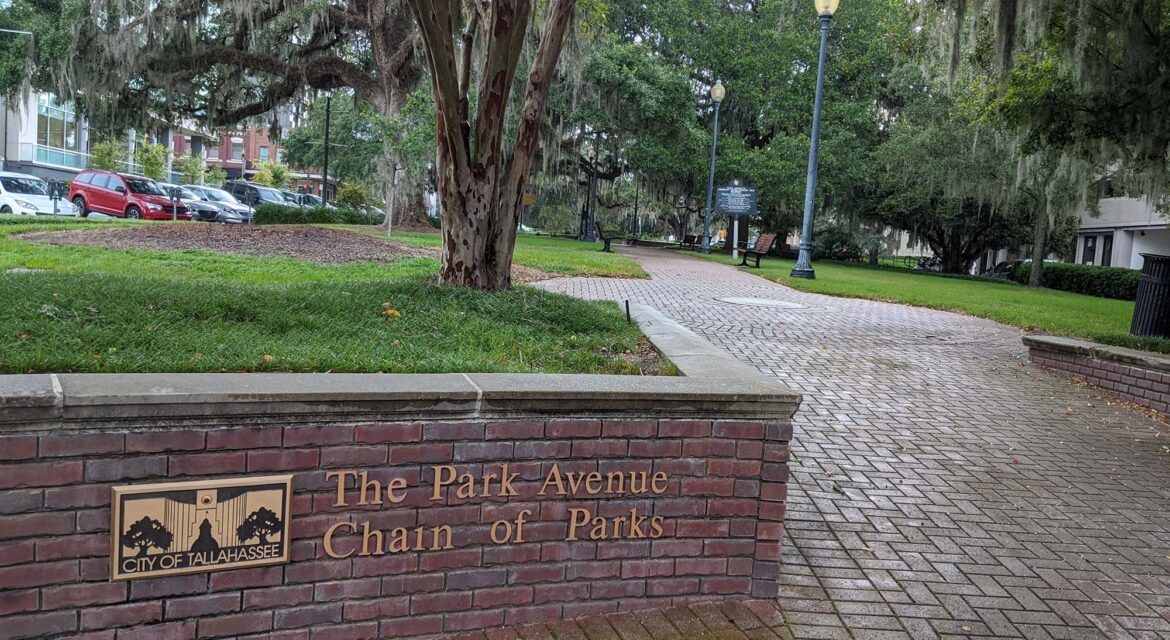 Seven downtown parks spread across successive city blocks are collectively known as the Chain of Parks in Tallahassee, Florida. Each of them has a strong and unique connection to the past and present of the city that has allowed them to become an essential element of the community. Their creativity has been officially recognized and has defined a powerful economic and cultural impact that can be seen across Tallahassee.
Seven downtown parks spread across successive city blocks are collectively known as the Chain of Parks in Tallahassee, Florida. Each of them has a strong and unique connection to the past and present of the city that has allowed them to become an essential element of the community. Their creativity has been officially recognized and has defined a powerful economic and cultural impact that can be seen across Tallahassee.

Seven Parks in One Chain
Covering seven blocks of public parks along present-day Park Avenue, the Chain of Parks were one of Tallahassee’s earliest features. They’re tied to the original northern border of the city, which was designed to be a buffer against attack from outside forces. Cherokee Park, E. Peck Greene Park, McCarty Park, Ponce de Leon Park, Bloxham Park, Lewis Park and Genevieve Randolph Park are the seven parks that make up the Chain of Parks.
 Lewis Park and Ponce de Leon Park were the first formal parks in the chain and date from the 1880s when they were developed for public use. Ponce de Leon Park was Tallahassee’s first dedicated park, while Lewis Park takes its name from the prominent Lewis family that has been involved in the financial, social and civic activities of Tallahassee for generations.
Lewis Park and Ponce de Leon Park were the first formal parks in the chain and date from the 1880s when they were developed for public use. Ponce de Leon Park was Tallahassee’s first dedicated park, while Lewis Park takes its name from the prominent Lewis family that has been involved in the financial, social and civic activities of Tallahassee for generations.
Cherokee Park was dedicated to the Cherokee Nation in 1938, while McCarthy Park is tied to a name that appeared on the original 1824 plan of Tallahassee. Blockham Park was the first landscape project of the Town Improvement Association, which was founded in 1891. Genevieve Randolph Park honors the founder of that group, which was established to enable the beautification of the city. Many of the trees planted by the group still shade the parks.
The City of Tallahassee Department of Parks, Recreation and Neighborhood Affairs maintains the Chain of Parks. The name “Chain of Parks” dates from 1994, when a master plan was adopted that unified the park and established measures to protect and enhance the canopy of live oaks that run across the parks.
The Chain of Parks reside in the heart of the Park Avenue Historic District, which was listed on the National Register of Historic Places in 1979. This history and notoriety have enabled audiences to engage with the space in countless ways.

Events, Activities and Awards
 Each park has a unique landscape and atmosphere. McCarty, Ponce de Leon and Bloxham are active places for public gatherings. The other parks are far quieter. Historical markers, time-capsules, plaques and other features call out notable people and events that have taken place in and around the parks, while the Old City Cemetery forms the western boundary of the Chain of Parks.
Each park has a unique landscape and atmosphere. McCarty, Ponce de Leon and Bloxham are active places for public gatherings. The other parks are far quieter. Historical markers, time-capsules, plaques and other features call out notable people and events that have taken place in and around the parks, while the Old City Cemetery forms the western boundary of the Chain of Parks.
Numerous organized and informal events take place across the parks. The parks are the centerpiece of annual celebrations such as Springtime Tallahassee, Winter Festival and Emancipation Day. However, the Chain of Parks Art Festival is arguably the most notable to take place. Recognized as north Florida’s premiere outdoor fine art festival, the annual event draws tens of thousands of people from the Big Bend Southeast region to see 165+ artists who have traveled from all over the country to display their original works. A pavilion and other permanent seating areas support and enable all of these types of activities and events.
In 1999, the American Society of Landscape Architects honored the Chain of Parks with a Centennial Medallion. In 2012, the organization recognized the Chain of Parks as one of Americas’ 100 Best Examples of Landscape Architecture. This recognition has helped the parks to attract the attention of audiences from across the region to positively impact the city in the present and future.

A Green Oasis in Tallahassee
 Highlighted in maps and guides to the city, the Chain of Parks provides visitors with a place to do anything from take a walk to partake in a community event. By imagining what it could look like to create a green oasis in Tallahassee, the Chain of Parks has established a legacy that compels engagement from the surrounding community and beyond.
Highlighted in maps and guides to the city, the Chain of Parks provides visitors with a place to do anything from take a walk to partake in a community event. By imagining what it could look like to create a green oasis in Tallahassee, the Chain of Parks has established a legacy that compels engagement from the surrounding community and beyond.

